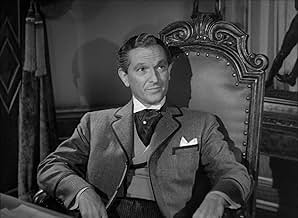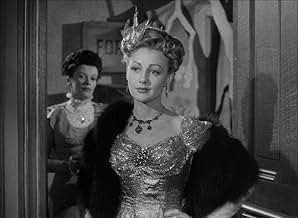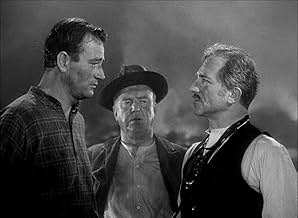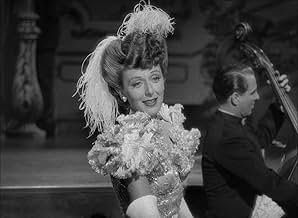VALUTAZIONE IMDb
6,2/10
1744
LA TUA VALUTAZIONE
Aggiungi una trama nella tua linguaA cowboy competes with a gambling tycoon on the Barbary Coast for the hand of a beautiful dance-hall queen.A cowboy competes with a gambling tycoon on the Barbary Coast for the hand of a beautiful dance-hall queen.A cowboy competes with a gambling tycoon on the Barbary Coast for the hand of a beautiful dance-hall queen.
- Candidato a 2 Oscar
- 2 candidature totali
Abdullah Abbas
- Saloon Patron
- (non citato nei titoli originali)
Eddie Acuff
- Fireman
- (non citato nei titoli originali)
Doc Adams
- Saloon Patron
- (non citato nei titoli originali)
Recensioni in evidenza
You gotta hand it to the Duke...his loyalty to the small Republic studios was admirable. They were the one that gave him his start in the movies and he never forgotten that as his movie star status grew and grew. It finally paid off when they both made "The Quiet Man" with a few Oscars no less in 1949-50. This movie was a prelude to that, and no Maureen O'Hara at that. Seriously, I loved Maureen, but towards the latter years of his career, she seemed to be in everyone of his pictures, including the aforementioned "Quiet Man". Joseph Schildkraut was a notable enemy, which he has performed in past movies. A, Dvorak pretty, and never acquired big star status, but most likely, one that the Republic studio could afford and Virginia Grey, Clark Gable's girl friend for many years." I Love Lucy"'s landlord has a comic turn here. One thing I noticed, where was Ward Bond? Another familiar face in the Duke's movies..
Flame of Barbary Coast finds John Wayne as a visiting cowboy from Montana who makes and loses a fortune in a night and goes home busted. He also finds the love of his life in Ann Dvorak, an entertainer at Joseph Schildkraut's place on the Barbary Coast.
Schildkraut figures that Dvorak is his personal property. But the Dvorak romantic angle is a side issue because Wayne is figuring on not getting mad, but getting even. He's learned a bit about gambling from an oldtimer at the trade in William Frawley.
Of course Wayne and Schildkraut's rivalry is interrupted by the famous earthquake of 1906. As this is Republic Films and not Metro-Goldwyn- Mayer, the special effects are nice, but not near as good as those from MGM. As this was Republic's prestige film of the year, I'm sure it was the best that miserly old Herbert J. Yates could afford.
The most interesting member of the cast is Schildkraut, a scion of the old Spanish aristocracy who's chosen to make his living on the Barbary Coast in the dens of iniquity there. He's as in love with Dvorak as Wayne is, but likes his power and notoriety more.
Yates took some liberties with San Francisco history in this one. The MGM San Francisco did not bother mentioning any of the local political figures of the day, but Flame on Barbary Coast did and got it wrong. Wayne and Schildkraut square off in an election in 1906 that never took place between Mayor Eugene Schmitz and James D. Phelan. Phelan was in fact Schmitz's predecessor in office and Schmitz didn't lose an election. He got himself impeached for setting a standard of corruption that has had some urban historian calling him the worst big city mayor in American history. Now THAT would be an interesting film.
Still the Duke's legion of fans will love him in this one and others will like Joseph Schildkraut.
Schildkraut figures that Dvorak is his personal property. But the Dvorak romantic angle is a side issue because Wayne is figuring on not getting mad, but getting even. He's learned a bit about gambling from an oldtimer at the trade in William Frawley.
Of course Wayne and Schildkraut's rivalry is interrupted by the famous earthquake of 1906. As this is Republic Films and not Metro-Goldwyn- Mayer, the special effects are nice, but not near as good as those from MGM. As this was Republic's prestige film of the year, I'm sure it was the best that miserly old Herbert J. Yates could afford.
The most interesting member of the cast is Schildkraut, a scion of the old Spanish aristocracy who's chosen to make his living on the Barbary Coast in the dens of iniquity there. He's as in love with Dvorak as Wayne is, but likes his power and notoriety more.
Yates took some liberties with San Francisco history in this one. The MGM San Francisco did not bother mentioning any of the local political figures of the day, but Flame on Barbary Coast did and got it wrong. Wayne and Schildkraut square off in an election in 1906 that never took place between Mayor Eugene Schmitz and James D. Phelan. Phelan was in fact Schmitz's predecessor in office and Schmitz didn't lose an election. He got himself impeached for setting a standard of corruption that has had some urban historian calling him the worst big city mayor in American history. Now THAT would be an interesting film.
Still the Duke's legion of fans will love him in this one and others will like Joseph Schildkraut.
Before watching Flame Of Barbary Coast I never read the description on the back cover of the DVD case. It mentions the San Francisco earthquake of 1906. Fortunately I was aware of some of the history of that earthquake, so I was picking up the clues given throughout the movie. All I cared about before watching the movie was that it was a western with John Wayne in it. The movie is a "late" western in that it takes place as the wild west had been tamed and the 20th Century was becoming an entirely different reality.
The plot was okay, but a little thin. A Montana rancher goes to the big city, finds himself played out as a sucker, and returns to conquer the same people who made a fool out of him. Duke Fergus (John Wayne) takes lessons from his professional gambler friend, Wolf Wylie (William Frawley), and ends up beating the professional gamblers in their own casinos. Even for John Wayne this is quite amazing. Added to that is his love interest in Flaxen (Ann Dvorak), known as "the Flame of the Barbary Coast", who apparently has teased virtually every powerful man in town. At the time of the story she is tied to Tito Morrell (Joseph Schildkraut), the most successful and notorious of the gambling house bosses.
I liked the way Joseph Schildkraut played the classy, but devious, casino owner, Tito Morrell. His character hinted at aristocratic old world lineage and his determination to maintain a level of sophistication despite his present reputation. Tito's criminal side is never shown, only implied. John Wayne's character, Duke, never came across as simple. He loved his modest environment at his ranch in Montana, but he had a business sense and some integrity. Ann Dvorak's Flaxen is the character that seems a bit odd. If she has such a reputation for being the unobtainable prize, why do so many still want her? She really does smile her way through everything, too. It would have been really nice if she got one of those famous John Wayne spankings.
Establishing a specific time was done gradually and then deliberately. The house Tito provides for Flaxen is definitely built in an elaborate turn of the century European-influenced style that would not have existed thirty years earlier. Upon arriving in San Francisco there were many electric lights. A bathroom with running water is shown. Eventually a specific date in January of 1906 is mentioned, and later it is mentioned that April of the same year has arrived. Although everyone is moving on foot or in a horse drawn carriage, an automobile appears in one scene. The time placement was subtle in the beginning and made perfectly clear as it became more important to the plot.
I expected the climax of the movie to be the famous San Francisco earthquake. There really were explosions and gas fires from ruptured natural gas lines. Firefighters are shown in the movie running out of water because of broken water mains just as the real firefighters did. It is even mentioned that looters would be shot, as they really were. The catalyst that brought about changes in San Francisco set up the final scenes for the main characters. The true nature of everyone is shown in a final showdown between Duke, Tito, and Flaxen.
I liked Flame Of Barbary Coast. My only complaint is that the movie makes the Barbary Coast seem to be the most important part of San Francisco, and it is the only part of the city that is shown. The sets were elaborate and the actors were good. It cannot be called a gangster movie even though it has crime bosses. Over all it was more of a drama than a western, but it was worth watching.
The plot was okay, but a little thin. A Montana rancher goes to the big city, finds himself played out as a sucker, and returns to conquer the same people who made a fool out of him. Duke Fergus (John Wayne) takes lessons from his professional gambler friend, Wolf Wylie (William Frawley), and ends up beating the professional gamblers in their own casinos. Even for John Wayne this is quite amazing. Added to that is his love interest in Flaxen (Ann Dvorak), known as "the Flame of the Barbary Coast", who apparently has teased virtually every powerful man in town. At the time of the story she is tied to Tito Morrell (Joseph Schildkraut), the most successful and notorious of the gambling house bosses.
I liked the way Joseph Schildkraut played the classy, but devious, casino owner, Tito Morrell. His character hinted at aristocratic old world lineage and his determination to maintain a level of sophistication despite his present reputation. Tito's criminal side is never shown, only implied. John Wayne's character, Duke, never came across as simple. He loved his modest environment at his ranch in Montana, but he had a business sense and some integrity. Ann Dvorak's Flaxen is the character that seems a bit odd. If she has such a reputation for being the unobtainable prize, why do so many still want her? She really does smile her way through everything, too. It would have been really nice if she got one of those famous John Wayne spankings.
Establishing a specific time was done gradually and then deliberately. The house Tito provides for Flaxen is definitely built in an elaborate turn of the century European-influenced style that would not have existed thirty years earlier. Upon arriving in San Francisco there were many electric lights. A bathroom with running water is shown. Eventually a specific date in January of 1906 is mentioned, and later it is mentioned that April of the same year has arrived. Although everyone is moving on foot or in a horse drawn carriage, an automobile appears in one scene. The time placement was subtle in the beginning and made perfectly clear as it became more important to the plot.
I expected the climax of the movie to be the famous San Francisco earthquake. There really were explosions and gas fires from ruptured natural gas lines. Firefighters are shown in the movie running out of water because of broken water mains just as the real firefighters did. It is even mentioned that looters would be shot, as they really were. The catalyst that brought about changes in San Francisco set up the final scenes for the main characters. The true nature of everyone is shown in a final showdown between Duke, Tito, and Flaxen.
I liked Flame Of Barbary Coast. My only complaint is that the movie makes the Barbary Coast seem to be the most important part of San Francisco, and it is the only part of the city that is shown. The sets were elaborate and the actors were good. It cannot be called a gangster movie even though it has crime bosses. Over all it was more of a drama than a western, but it was worth watching.
If you want to see the electric lines in SF in 1906 check out the links listed below from the SF Museum. These two slides in the power point show the lines that were present then.
I think that the level of electric service shown in the film was a little advance for 1906, most would not pick upon that. Remember this was a 1945 film, compare it to the 50's not present day films to be fair. Acting talent still beats special effects in my book. Just think what kind of movies John Wayne could do in 2005 with just a few of today's effects. Maybe some one could apply CGI to an older movie? Good movie, to bad we get so few good movies in the current productions.
http://www.sfmuseum.org/views/1906.ppt#262,8,Slide 8
http://www.sfmuseum.org/views/1906.ppt#264,13,Slide 12
Check out the rest of the site worth the time, just as this movie is.
I think that the level of electric service shown in the film was a little advance for 1906, most would not pick upon that. Remember this was a 1945 film, compare it to the 50's not present day films to be fair. Acting talent still beats special effects in my book. Just think what kind of movies John Wayne could do in 2005 with just a few of today's effects. Maybe some one could apply CGI to an older movie? Good movie, to bad we get so few good movies in the current productions.
http://www.sfmuseum.org/views/1906.ppt#262,8,Slide 8
http://www.sfmuseum.org/views/1906.ppt#264,13,Slide 12
Check out the rest of the site worth the time, just as this movie is.
John Wayne, Duke Fergus, is tagged "King of Luck", after breaking the bank in several casino saloons with the help of Ann Dvorak, as Ann 'Flaxen' Tarry, who says, "You've just been promoted". From Duke to King. How ironic that the man known as The Duke in his lifetime had to be the object of this tongue-in-cheek line. Some would think that The Duke was above being a king. This movie does fit the small screen (of t.v), but maybe it was appropriate for the large screen in 1945 when folks weren't so jaded in their viewings. The real gem of this movie is Joseph Schildkraut, as Boss Tito Morell. How could a shady bad guy be so lovable? We love the under dog. Is there any question that The Duke will walk away with the lady? But Tito is the one who really loves Flaxen, and always holds back from resorting to "fixing" The Duke as his cronies want to do. He may be the evil foil, but you can't help but love this gentleman scoundrel. Loyalty does not pay in the end for our hapless romantic. And talk about obsession: the suitors of Flaxen still hang around even when it seems she will be paralyzed for life after the Great Earthquake (did San Francisco really have electric poles in 1906?!)--they hope the old trooper will return to the stage and awe their hearts, not to mention their libidos! As Flaxen is whisked off in Duke's carriage to Montana, Tito has the best line: "Compliments of the House"....
Lo sapevi?
- QuizWhile in her home, Ann Dvorak introduces herself to John Wayne: "My name is Ann" to which he replies "and I am Duke". Dvorak's character's name is also her real name. Wayne's character's name was also his real-life nickname.
- BlooperJames D. "Jim" Phelan was Mayor of San Francisco from 1897 until 1902, serving 3 terms. He did not run for Mayor after the 1906 earthquake, but served on the Committee of Fifty, set up by the Mayor, Eugene Schmitz.
- Citazioni
'Smooth' Wylie: Now the first thing to learn about a deck of cards is how to handle 'em. They're a whole lot like women, usually when you pick one up, you wish you hadn't!
- Versioni alternativeAlso available in a computer colorized version.
- ConnessioniEdited into The Green Fog (2017)
- Colonne sonoreBy the Light of the Silvery Moon
(uncredited)
Music by Gus Edwards
Lyrics by Edward Madden
Performed by Ann Dvorak and the chorus
I più visti
Accedi per valutare e creare un elenco di titoli salvati per ottenere consigli personalizzati
- How long is Flame of Barbary Coast?Powered by Alexa
Dettagli
- Data di uscita
- Paese di origine
- Lingua
- Celebre anche come
- Fiamme alla costa dei barbari
- Luoghi delle riprese
- Azienda produttrice
- Vedi altri crediti dell’azienda su IMDbPro
Botteghino
- Budget
- 600.000 USD (previsto)
- Tempo di esecuzione
- 1h 31min(91 min)
- Colore
- Proporzioni
- 1.37 : 1
Contribuisci a questa pagina
Suggerisci una modifica o aggiungi i contenuti mancanti




















